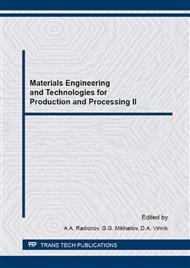[1]
J.W. Fergus, Recent developments in cathode materials for lithium ion batteries, Journal of Power Sources. 195 (2010) 939-954.
DOI: 10.1016/j.jpowsour.2009.08.089
Google Scholar
[2]
B. Gao, A. Kleinhammes, X.P. Tang, C. Bower, L. Fleming, Y. Wu, O. Zhou, Electrochemical intercalation of single-walled carbon nanotubes with lithium, Chemical Physics Letters. 307 (1999) 153-157.
DOI: 10.1016/s0009-2614(99)00486-8
Google Scholar
[3]
J. Zhao, A. Buldum, J. Han, J.P. Lu, First-Principles Study of Li-Intercalated Carbon Nanotube Ropes, Phys. Rev. Lett. 85 (2000) 1706-09.
DOI: 10.1103/physrevlett.85.1706
Google Scholar
[4]
W. Kong, L. Sun, Y. Wu, K. Jiang, Q. Li, J. Wang, S. Fan, Binder-free polymer encapsulated sulfur-carbon nanotube composite cathodes for high performance lithium batteries, Carbon. 96 (2016) 1053-1059.
DOI: 10.1016/j.carbon.2015.10.062
Google Scholar
[5]
T.K. Kim, C.S. Rustomji, H. -M. Cho, D. Chun, J. -Y. Jung, E. Caldwell, S. Jin, Multi-wall carbon nanotube-embedded lithium cobalt phosphate composites with reduced resistance for high-voltage lithium-ion batteries, Electronic Materials Letters. 12 (2016).
DOI: 10.1007/s13391-015-5310-8
Google Scholar
[6]
M. Ye, C. Hu, L. Lv, L. Qu, Graphene-winged carbon nanotubes as high-performance lithium-ion batteries anode with super-long cycle life, Journal of Power Sources. 305 (2016) 106-114.
DOI: 10.1016/j.jpowsour.2015.11.098
Google Scholar
[7]
X. Li, M. Rao, W. Li, Sulfur encapsulated in porous carbon nanospheres and coated with conductive polyaniline as cathode of lithium–sulfur battery, Journal of Solid State Electrochemistry. 20 (2016) 153-161.
DOI: 10.1007/s10008-015-3013-6
Google Scholar
[8]
S. Yoon, S. Lee, S. Kim, K. -W. Park, D. Cho, Y. Jeong, Carbon nanotube film anodes for flexible lithium ion batteries, Journal of Power Sources. 279 (2015) 495-501.
DOI: 10.1016/j.jpowsour.2015.01.013
Google Scholar
[9]
E.Y. Matsubara, C. Luengo, J.M. Rosolen, Lithium-doped endohedral single-walled carbon nanotubes can arise during tube growth, Chemical Physics Letters. 590 (2013) 175-179.
DOI: 10.1016/j.cplett.2013.10.077
Google Scholar
[10]
S.A. Sozykin, V.P. Beskachko, Structure of endohedral complexes of carbon nanotubes encapsulated with lithium and sodium, Molecular Physics. 111 (2013) 930-938.
DOI: 10.1080/00268976.2012.760049
Google Scholar
[11]
M. Khantha, N.A. Cordero, J.A. Alonso, M. Cawkwell, L.A. Girifalco, Interaction and concerted diffusion of lithium in a (5, 5) carbon nanotube, Physical Review B. 78 (2008) 115430.
DOI: 10.1103/physrevb.78.115430
Google Scholar
[12]
G. Mpourmpakis, E. Tylianakis, D. Papanikolaou, G. Froudakis, Theoreical study of alkaline metal cations in carbon nanotubes, Reviews on Advanced Materials Science. 11 (2006) 92-97.
Google Scholar
[13]
Y. Liu, H. Yukawa, M. Morinaga, First-principles study on lithium absorption in carbon nanotubes. Computational Materials Science. 30 (2004) 50-56.
DOI: 10.1016/j.commatsci.2004.01.035
Google Scholar
[14]
K.S. Virdi, K.C.H. Kumar, First-principle Investigation of Lithium Intercalation Behavior of a (3; 3), Materials Science Forum. 736 (2013) 27-31.
DOI: 10.4028/www.scientific.net/msf.736.27
Google Scholar
[15]
M. Soler, E. Artacho, J.D. Gale, A. Garc, J. Junquera, P. Ordej, S. Daniel, The SIESTA method for ab initio order- N materials, J. Phys.: Condens. Matter. 14 (2002) 2745-2779.
DOI: 10.1088/0953-8984/14/11/302
Google Scholar
[16]
Information on http: /supercomputer. susu. ac. ru/en.
Google Scholar
[17]
H.J. Monkhorst, J. Pack, Special points for Brillouin-zone integrations, Physical Review B. 13 (1976) 5288-5192.
DOI: 10.1103/physrevb.13.5188
Google Scholar
[18]
M. Senami, Y. Ikeda, A. Fukushima, A. Tachibana, Theoretical study of adsorption of lithium atom on carbon nanotube, AIP ADVANCES. 1 (2011) 042106.
DOI: 10.1063/1.3651182
Google Scholar
[19]
A.L. Companion, A new diatomics-in-molecules study of Li3 and Li4, Chemical Physics Letters. 56 (1978) 500-502.
DOI: 10.1016/0009-2614(78)89025-3
Google Scholar
[20]
B.M. Smirnov, A.S. Yatsenko, Properties of dimers, Physics-Uspekhi. 39 (1996) 211-230.
Google Scholar
[21]
Y. Liu, H. Yukawa, M. Morinaga, Local electronic structure of lithium absorbed in carbon nanotubes, Molecular Crystals and Liquid Crystals. 387 (2002) 323-329.
DOI: 10.1080/10587250215235
Google Scholar


